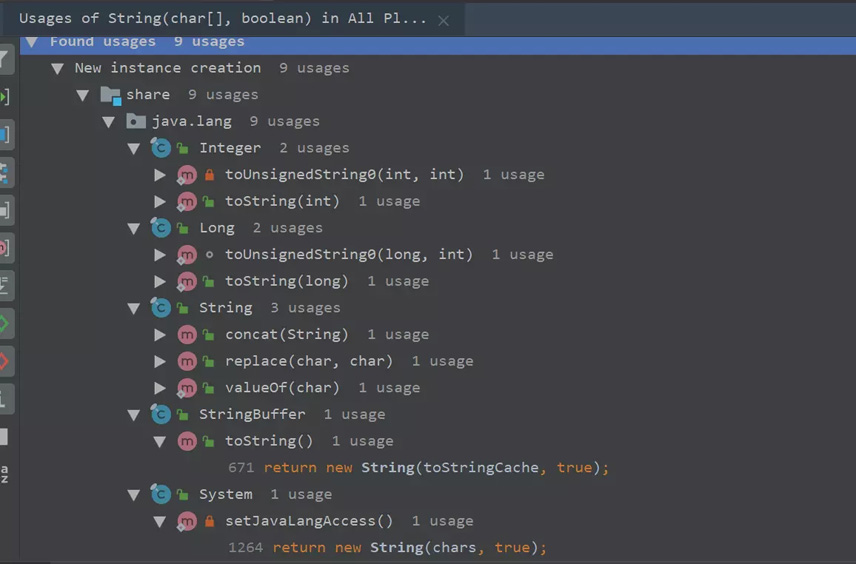文中相关源码: string.java
今天来说说 string。
贯穿全文,你需要始终记住这句话,string 是不可变类 。其实前面说过的所有基本数据类型包装类都是不可变类,但是在 string 的源码中,不可变类 的概念体现的更加淋漓尽致。所以,在阅读 string 源码的同时,抽丝剥茧,你会对不可变类有更深的理解。
什么是不可变类 ?
首先来看一下什么是不可变类?effective java 第三版 第 17 条 使不可变性最小化 中对 不可变类 的解释:
不可变类是指其实例不能被修改的类。每个实例中包含的所有信息都必须在创建该实例的时候就提供,并在对象的整个生命周期 (lifetime) 内固定不变 。
为了使类成为不可变,要遵循下面五条规则:不要提供任何会修改对象状态的方法(也称为设值方法) 。
保证类不会被扩展。 为了防止子类化,一般做法是声明这个类成为 final 的。
声明所有的域都是 final 的。
声明所有的域都为私有的。 这样可以防止客户端获得访问被域引用的可变对象的权限,并防止客户端直接修改这些对象 。
确保对于任何可变组件的互斥访问。 如果类具有指向可变对象的域,则必须确保该类的客户端无法获得指向这些对象的引用 。 并且,永远不要用客户端提供的对象引用来初始化这样的域,也不要从任何访问方法( accessor)中返回该对象引用 。 在构造器、访问方法和 readobject 方法(详见第 88 条)中请使用保护性拷贝( defensive copy )技术(详见第50 条) 。
根据这五条原则,来品尝一下 string.java 吧!
类定义
|
1
2
|
public final class string implements java.io.serializable, comparable<string>, charsequence {} |
对应原则第二点 保证类不会被扩展,使用 final 修饰。此外:
- 实现了 serializable 接口,具备序列化能力
- 实现了 comparable 接口,具备比较对象大小能力,根据单字符的大小比较。
- 实现了 charsequence 接口,表示是一个字符序列,实现了该接口下的一些方法。
字段
|
1
2
3
|
private final char value[]; // 储存字符串private int hash; // 哈希值,默认为 0private static final long serialversionuid = -6849794470754667710l; // 序列化标识 |
看起来 string 是一个独立的对象,其实它是使用基本数据类型的数组 char[] 实现的。作为使用者,我们不需要打开 string 的黑匣子,直接根据它的 api 使用就可以了,这正是 java 的封装性的体现。但是作为开发者,我们就有必要一探究竟了。
private final char value[] , 对应原则中第三条和第四条,声明所有的域都是 final 的 ,声明所有的域都为私有的。看到这里,你大概明白了一点为什么 string 不可变。因为真正用来存储字符串的字符数组是 final 修饰的,是不可变的。
构造函数
string 的构造函数很多,大致可以分为以下四种:
无参构造
|
1
2
3
|
public string() { this.value = "".value;} |
无参构造默认构建一个空字符串。鉴于 string 是不可变类,所以此构造器并没有什么意义,一般你也不会去构建一个不可变的空字符串对象。
参数是 byte[]
|
1
2
3
4
5
6
|
public string(byte bytes[]) {}public string(byte bytes[], int offset, int length) {}public string(byte bytes[], charset charset) {}public string(byte bytes[], string charsetname) {}public string(byte bytes[], int offset, int length, charset charset) {}public string(byte bytes[], int offset, int length, string charsetname) {} |
已经废弃的就不再列举了。上面这些构造函数都差不多,最后都是调用 stringcoding.decode() 方法将字节数组转换为字符数组,再赋值给 value[]。这里要注意一点,参数未指定编码格式的话,默认使用系统的编码格式,如果没有获取到系统编码格式,则使用 iso-8859-1 格式。
参数是 char[]
参数是 char[] 的构造函数有 3 个,逐个看一下:
|
1
2
3
|
public string(char value[]) { this.value = arrays.copyof(value, value.length);} |
为了保证不可变性,并没有直接赋值,this.value = value。而是使用 arrays.copy() 方法将参数中的字符数组内容拷贝到 value[] 中。防止参数中字符数组的改变破坏了不可变性。
第二个:
|
1
2
3
4
5
6
7
8
9
10
11
12
13
14
15
16
17
18
19
|
public string(char value[], int offset, int count) { if (offset < 0) { throw new stringindexoutofboundsexception(offset); } if (count <= 0) { if (count < 0) { throw new stringindexoutofboundsexception(count); } if (offset <= value.length) { this.value = "".value; return; } } // note: offset or count might be near -1>>>1. if (offset > value.length - count) { throw new stringindexoutofboundsexception(offset + count); } this.value = arrays.copyofrange(value, offset, offset+count);} |
和上面的构造函数一样,只是截取了参数中字符数组的一部分来构建字符串。
第三个:
|
1
2
3
4
5
6
7
8
9
10
11
12
13
14
|
/* * package private constructor which shares value array for speed. * this constructor is always expected to be called with share==true. * a separate constructor is needed because we already have a public * string(char[]) constructor that makes a copy of the given char[]. * * 仅当前包可使用。 * 直接将 this.value 指向参数中的 char[],不再进行 copy 操作 * 性能好,节省内存,外包不可使用,也不会破坏不可变性 */ string(char[] value, boolean share) { // assert share : "unshared not supported"; this.value = value; } |
这里的 share 一般只能为 true,虽然并没有使用到。增加这个参数是为了和第一个构造函数区分开来,表示 value[] 共享了参数中的字符数组,因为这里是直接赋值的,并没有使用 arrays.copy() 。那这不是破坏了 string 的不可变性吗?其实并没有,因为你根本没法调用这个构造函数,它的包私有的。但是在 jdk 内部你可以发现它的身影,

没有了 copy 操作,大幅提高了效率。但是为了保证不可变性,外部是不能调用的。
其他构造函数
|
1
2
3
4
5
6
7
8
9
10
11
12
13
14
|
// 基于代码点public string(int[] codepoints, int offset, int count) {} // 基于 stringbuffer,需要同步public string(stringbuffer buffer) { synchronized(buffer) { this.value = arrays.copyof(buffer.getvalue(), buffer.length()); }}// 基于 stringbuilder,不需要同步public string(stringbuilder builder) { this.value = arrays.copyof(builder.getvalue(), builder.length());} |
方法
回头再看一下 string 的不可变性,value[] 是 private final 修饰的,这样就真的可以保证不可变吗?
|
1
2
|
final char[] value = {'a','b','c'};value[1] = 'd'; |
这是不是就轻而易举的打破了不可变性?final value[] 只能保证其引用不能再指向其他内存地址,但是其真正的值还是可以改变的。所以仅仅通过一个 final 是无法保证其值不变的,如果类本身提供方法修改实例值,那就没有办法保证不变性了。对应原则中第一条,不要提供任何会修改对象状态的方法,string 百分之百做到了这一点,它没有对外提供任何可以修改 value 的方法。
在 string 中有许多对字符串进行操作的函数,例如 substring concat replace replaceall 等等,这些函数是否会修改类中的 value 域呢?下面就来看一看源码。
substring(int beginindex)
|
1
2
3
4
5
6
7
8
9
10
11
|
public string substring(int beginindex) { if (beginindex < 0) { throw new stringindexoutofboundsexception(beginindex); } int sublen = value.length - beginindex; if (sublen < 0) { throw new stringindexoutofboundsexception(sublen); } // beginindex 不为 0, 返回一个 新的 string 对象 return (beginindex == 0) ? this : new string(value, beginindex, sublen); } |
concat(string str)
|
1
2
3
4
5
6
7
8
9
10
|
public string concat(string str) { int otherlen = str.length(); if (otherlen == 0) { return this; } int len = value.length; char buf[] = arrays.copyof(value, len + otherlen); str.getchars(buf, len); return new string(buf, true); // 返回新的 string 对象} |
replace(char oldchar, char newchar)
|
1
2
3
4
5
6
7
8
9
10
11
12
13
14
15
16
17
18
19
20
21
22
23
24
25
26
|
public string replace(char oldchar, char newchar) { if (oldchar != newchar) { int len = value.length; int i = -1; char[] val = value; /* avoid getfield opcode */ while (++i < len) { if (val[i] == oldchar) { break; } } if (i < len) { char buf[] = new char[len]; for (int j = 0; j < i; j++) { buf[j] = val[j]; } while (i < len) { char c = val[i]; buf[i] = (c == oldchar) ? newchar : c; i++; } return new string(buf, true); // 返回新的 string 对象 } } return this;} |
string 类的方法实现都相对简单,但是无一例外,它们绝对不会去修改 value[] 的值,需要返回 string 对象的话,都会重新 new 一个。正像原则第五条中所说的,确保对于任何可变组件的互斥访问。 如果类具有指向可变对象的域,则必须确保该类的客户端无法获得指向这些对象的引用。
string.intern()
|
1
|
public native string intern(); |
这个方法比较特殊,是个本地方法。如果该字符串在常量池中已经存在,直接返回其引用。如果不存在,存入常量池再返回其引用。在下一篇文章中会进行详细介绍。
其他方法的源码就不列举了,感兴趣的可以到我上传的 jdk 源码 看看,string.java,添加了部分注释。
不可变类的好处
从头到尾都在说不可变类,那么它有哪些好处呢?
- 不可变对象比较简单。
- 不可变对象本质上是线程安全的,它们不要求同步。不可变对象可以被自由地共享。
- 不仅可以共享不可变对象,甚至也可以共享它们的内部信息。
- 不可变对象为其他对象提供了大量的构件。无论是可变的还是不可变的对象。
- 不可变对象无偿地提供了失败的原子性。
不可变类真正唯一的缺点是,对于每个不同的值都需要一个单独的对象。所以当需要大量字符串对象的时候,string 就成了性能瓶颈,这也催生了 stringbuffer 和 stringbuilder。后面会单独分析。
string 真的不可变吗 ?
学习就是自己不断打自己脸的过程。真的没有办法修改 string 对象的值吗?答案肯定是否定的,反射机制可以做到很多平常做不到的事情。
|
1
2
3
4
5
6
7
|
string str = "123";system.out.println(str);field field = string.class.getdeclaredfield("value");field.setaccessible(true);char[] value = (char[]) field.get(str);value[1] = '3';system.out.println(str); |
执行结果:
123
133
通过反射,的确修改了 value[] 的值。
总结
借着 string 源码,说了说 不可变类。简单总结一下 string 做了哪些措施来保证不可变性:
- value[] 使用 private final 修饰
- 构造函数中复制实参的值给 value[]
- 不对外提供任何修改 value[] 值的方法
- 需要返回 string 的方法,绝不返回原对象,都是重新 new 一个 string 返回
下一篇还是写 string , 说说 string 在内存中的位置和字符串常量池的一些知识,以及 string 相关的常见面试题。
好了,以上就是这篇文章的全部内容了,希望本文的内容对大家的学习或者工作具有一定的参考学习价值,谢谢大家对服务器之家的支持。
原文链接:https://juejin.im/post/5ca30c31f265da30c1724a04














